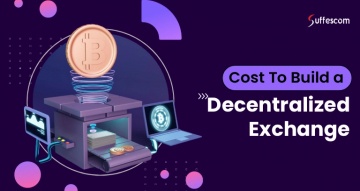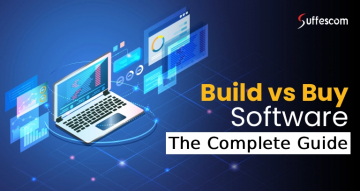How Much Does DeFi App Development Cost?

Understanding the DeFi app development cost is crucial before proceeding with the project. It costs extra if due consideration is not paid to analyze the cost components. In order to get complete advantages of DeFi development, it is essential to understand everything about the development cost.
The cost of DeFi lending platform development ranges between $10,000 to $30,000. This range includes various components, factors, and processes. Let’s break down the cost of DeFi lending app development in the following table -
| Cost Components | Included Components | Approx. Cost ($) | Cost Intensity |
| Development Cost | - DeFi Smart Contract Development - Frontend & Backend Development - Blockchain Integration - DeFi Protocol Development - API Integration | $4,000 – $12,000 | High |
| Security & Compliance Costs | - Smart Contract Audits - Penetration Testing - Regulatory Compliance | $2,000 – $6,000 | Medium-High |
| Infrastructure Costs | - Hosting & Servers - Database Management | $1,500 – $4,000 | Medium |
| UI/UX Design Costs | - Wireframing & Prototyping - Responsive Design | $1,000 – $3,500 | Low-Medium |
| Testing & Deployment Costs | - Testnet Deployment - Automated & Manual Testing | $1,500 – $4,500 | Medium |
Minimum DeFi App Development Cost with Suffescom Solutions!
We develop the best platform for you at a low cost for the DeFi lending platform. Without further ado, connect now and get a no-cost consultation.
Breakdown of the Cost of the DeFi Lending App
Though reliable project rescue services can help to get the project back on track, if it gets jeopardized due to inefficient cost analysis, but it is wise to avoid such a situation.
DeFi App Development Costs
A complete DeFi app development project undergoes various development milestones that involve-
DeFi Smart Contract Development
It is the process of developing automated contracts that self-execute on the fulfillment of the contractual terms. DeFi smart contract development is an essential cost component as it assists in handling transactions such as lending or staking.
Frontend and Backend Development
The development team creates a user interface (UI) that helps users interact with the application. Whereas, the backend development underlies logic and functionality powered by smart contracts on a blockchain network.
Blockchain Integration
This step involves integrating Ethereum, Solana, or any other blockchain networks in the decentralized finance applications to increase financial security, transparency, programmability, interoperability, and immutability.
DeFi Protocol Development
Developing a protocol is the foundational step of DeFi platform development. The complexity and auditing of the protocols affect the DeFi lending platform development cost. The more complex the DeFi protocol is, the higher the cost.
API Integration
API increases the functionality of an application by integrating various applications. Third-party API integration allows data and transactions to be seamless. Various API types, including blockchain, wallet, exchange or liquidity, and analytics APIs, incur different development costs.
Security and Compliance Costs
Security checks and compliance fulfillment are the top considerations of the DeFi lending platform development.
Smart Contract Audits
The cost of a smart contract audit depends upon several factors, such as the project’s complexity and scale. Also, the expertise level of the auditing team decides how much smart contract audits will cost.
Penetration Testing
Penetration testing holds greater importance in maintaining the security levels of the DeFi application. The two significant components of penetration testing are Network and API Security testing and Bug Bounty programs that alter the cost of DeFi lending platform.
Regulatory Compliance
Different compliance asks for different cost levels-
1. KYC & AML compliance - Third-party solutions like Jumio help apply Know Your Customer (KYC) and Anti-Money Laundering (AML) compliance.
2. Legal consultation - Compliance regulations need legal advisors, which brings costs.
Infrastructure Costs
Infrastructure is the backbone of a DeFi application. It has to be robust enough to function smoothly during transactional load.
Hosting & Servers
The cost of cloud-based (Google or AWS) and on-premise infrastructure differs. Also, the scalability requirement for servers and hosting calls for additional cost.
Database Management
A database is the most crucial element of a DeFi platform. The admin can choose between on-chain and off-chain storage. Additionally, the DeFi platforms need real-time market data, which eventually increases API costs.
UI/UX Design Costs
An appealing and user-friendly design requires higher costs as it requires the expertise and experience of the designers. The two major UI/UX design components are wireframing & prototyping and responsive design. Both require additional knowledge and skill sets.
Testing & Deployment Costs
Without incurring these costs, it is really complex to achieve the best potential of DeFi applications. Moreover, it will bring higher costs if compromised on testing.
1. Testnet Deployment includes blockchain fees, node setup & maintenance, smart contract debugging, and integration testing.
2. Automated & Manual Testing includes fuzz, unit & integration, and load testing.
Examining the Factors Affecting the Cost of DeFi Lending Platform
Let’s understand the factors that affect the cost of DeFi lending platform.
Application Type & Complexity
The DeFi application type decides its complexity, which determines the DeFi lending platform development cost.
1. DeFi Lending/Borrowing Platforms – Needs complex smart contracts for collateralization, interest calculations, and liquidation mechanisms.
2. Decentralized Exchanges (DEX) – Requires liquidity pools, AMM mechanisms, and token-swapping functionalities.
3. Yield Farming & Staking Platforms – Involves reward distribution mechanisms, liquidity mining, and governance token integration.
4. DeFi Aggregators & Portfolio Management Apps – Require multi-protocol integration for real-time data fetching and analytics.
Choosing the DeFi app type features, complexity and functionalities determines the DeFi lending platform development cost. The complexities arise from implementing difficult smart contracts, integrating several blockchain networks, or creating complex financial tools.
Also, the DeFi app's complexity increases after including decentralized governance models.
These app complexities increase the application's testing, development, and auditing process.
Selecting the Blockchain Network
The choice of blockchain network majorly impacts app development costs because of dynamic development environments. Some of the popular blockchain networks-
Ethereum - Robust smart contract security but higher gas fees
Binance Smart Chain (BSC) - Lower gas fee but lesser decentralization
Polygon - Faster and cheaper transactions
Solana, Avalanche, or Polkadot - High-speed transaction but needs custom integrations
Blockchain factors like network scalability and security highly impact the development cost. The chosen blockchain network's ecosystem and the available development tools are crucial in determining the complete cost of the DeFi lending app.
Security Measures
Undoubtedly, security is vital in the DeFi platform, and it is wise to invest in implementing effective security measures. Security controls and audits increase the cost of DeFi lending platform. Additionally, protecting user assets and data depends on applying security mechanisms such as signature wallets, secure coding techniques, and the latest third-party security audits.
Design Complexities
The more complex the design is, the more cost it will incur. Remember, DeFi platforms need to have an intuitive interface. Though UI/UX designs increase the DeFi platform development cost, it ensures the app achieves maximum user satisfaction.
Incorporating interactive components like friendly design and user-friendly navigation requires extensive research, including user research and testing, which requires costs.
Integration with External Services
In order to enable super functionality in the DeFi platform, there arises a need to integrate third-party services or software. For example, payment gateway integration for smooth payment processing.
Such integration includes asset management, automated testing, and more. It is important to focus on testing and auditing practices for higher security.
Overview of the Working Model of DeFi Apps
Blockchain technology and smart contracts are the two most essential components of DeFi applications. These enable the DeFi platform to execute financial transactions without dependency on conventional intermediaries.
- The process of DeFi apps’ operations starts with-
- Users conduct various DeFi transactions, such as trading, lending, or borrowing digital assets.
- Then, smart contracts automatically execute the transaction upon fulfillment of contractual terms.
- After initiation, the nodes verify and record the transaction on the blockchain to streamline operations and improve accessibility.
The working model is as basic as it gets. The real functionality lies in the core features of the DeFi that make an intricate model seem so simple.
Understanding the Core Features of DeFi Apps
The core features decide the efficiency levels and the cost of a DeFi lending platform. Following are some crucial features of the decentralized financial applications that not only impact the cost levels but increase the efficiency levels as well.
Lightning Fast Payments
The whole idea of decentralizing is to increase the transactional speed and maximize efficiency. There's no point in decentralizing systems if they do not enable fast financial transactions. It is extremely vital for the DeFi app to allow quick transactions for efficient trading practices.
High Interoperability
Easy integration with multiple DeFi platforms and blockchains, seamless functionality and operations. The user can perform a wide variety of operations with high interoperability, allowing for maximum usage of DeFi applications.
Token Swapping
Token swapping ensures lower transaction fees and faster transaction speed. This process deals with exchanging one crypto asset for another without converting it to fiat currency directly.
Lending and Borrowing
This feature allows users to tap the potential of automated and decentralized processes for lending and borrowing digital assets.
Yield Farming
This feature rewards the users for supplying liquidity to DeFi protocols using lending or staking. These rewards are usually paid in the form of the protocol's governance tokens.
Staking
Staking is a method of earning rewards by locking cryptocurrency into a blockchain network for a specific time period. It allows users to utilize staked assets in various ways to improve capital efficiency.
Smart Contracts
To improve operational efficiency, smart contracts perform automatic transactions as per predefined conditions without any dependency or intervention.
Decentralized Governance
This feature enables seamless voting mechanisms that empower users to participate in the platform's decision-making process.
Wallet Integration
Integrating wallets facilitates seamless asset management practices and transactions. Users can secure and safeguard payment information like credit cards and bank accounts.
Collateral Management
It adds a disciplinary practice that assures borrowers that they can maintain the financial health of the assets they borrow. Collateral management enables monitoring and controlling collateral assets to secure loans and other financial activities.
Automated Market Making (AMM)
It enables automatic trading of digital assets, as AMMs operate using liquidity pools and a consistent mathematical formula to determine prices.
Stages of DeFi App Development
Here’s the comprehensive and detail-oriented process of DeFi app development. Each of the following steps impacts the cost of DeFi lending app.
Conceptualization and Research
- Identifying business needs, target audience, and market trends.
- Research and analysis of existing DeFi apps and identify gaps.
- Define business goals and objectives.
Define Core Features and Functionality
- Decide on core features like staking, lending, liquidity pools, etc.
- Specify transaction models and tokenomics.
- Outline user roles and permissions of admin, investor, etc.
Choose Blockchain Platform
- Select an ideal blockchain from Ethereum, Binance Smart Chain, etc.
- Ensure scalability, security, and decentralization by assessing the transaction speed and cost.
Smart Contract Development
- Write and deploy smart contracts that govern app functionality.
- Ensure transparency, security, and error-free code.
- Use Solidity or other smart contract languages.
UI and UX Design
- Design a user-friendly interface with a focus on accessibility.
- Implement compatibility with both desktop and mobile devices.
Decentralized Application (DApp) Development
- Developing the front-end and back-end architecture.
- Blockchain integration for seamless operation.
Wallets Integration
- Integrate popular wallets such as MetaMask, Trust Wallet, etc.
- Enable secure wallet connection and consistent support.
Security Implementation
- Comprehensive security audit.
- Implementing encryption protocols for transactions.
Testing and Quality Assurance
- Test the application on multiple devices and environments.
- Perform stress and load testing to assess scalability.
- Conduct security testing to identify potential vulnerabilities.
Launch and Deployment
Deploy the app to the blockchain.
Release the app to app stores or provide web access.
Post-Launch Maintenance and Updates
- Monitor the app's performance and fix bugs.
- Roll out updates to improve functionality and security.
- Customer support and address user feedback.
Best DeFi Solutions Under Lowest DeFi App Development Cost
Looking for a reliable service that delivers the best solutions under minimum DeFi lending platform development cost? If so, Suffescom Solutions is the place to be!
Frequently Asked Questions on DeFi App Development Cost
How Much Does DeFi App Development Cost?
The cost of a DeFi lending app is between $10,000 to $30,000. This includes various components such as development, security & compliance, infrastructure, UI/UX design, testing & deployment costs. Also, multiple factors, such as application type & complexity, chosen blockchain network, security measures, design complexities, and integration with external services.
How Do DeFi Lending Protocols Make Money?
The most common source for a DeFi lending protocol to make money is transaction fees, which are charged to users when they take DeFi services such as lending or trading. Another revenue method is extracting minute bps between borrowing and lending rates.
Which is the best DeFi app development service?
The DeFi app development service that provides the best solutions under fair DeFi lending platform development cost is Suffescom Solution. The company has been providing reliable services for more than a decade!








